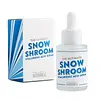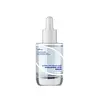What's inside
What's inside
 Key Ingredients
Key Ingredients

 Benefits
Benefits

 Ingredients Side-by-side
Ingredients Side-by-side

Water
Skin ConditioningPropanediol
SolventPentylene Glycol
Skin ConditioningGlycerin
HumectantLonicera Caprifolium Flower Extract
PerfumingSodium Hyaluronate
HumectantHydrolyzed Sodium Hyaluronate
Skin ConditioningLonicera Japonica Flower Extract
Skin ConditioningTremella Fuciformis Polysaccharide
Emulsion StabilisingTamarindus Indica Seed Gum
Emulsion StabilisingSodium Phytate
Sodium Bicarbonate
AbrasiveMelia Azadirachta Leaf Extract
Skin ConditioningMelia Azadirachta Flower Extract
Skin ConditioningCorallina Officinalis Extract
Skin ConditioningCoccinia Indica Fruit Extract
Skin ConditioningSolanum Melongena Fruit Extract
Skin ConditioningAloe Barbadensis Flower Extract
EmollientOcimum Sanctum Leaf Extract
Skin ConditioningOcimum Basilicum Flower/Leaf Extract
TonicCurcuma Longa Root Extract
MaskingWater, Propanediol, Pentylene Glycol, Glycerin, Lonicera Caprifolium Flower Extract, Sodium Hyaluronate, Hydrolyzed Sodium Hyaluronate, Lonicera Japonica Flower Extract, Tremella Fuciformis Polysaccharide, Tamarindus Indica Seed Gum, Sodium Phytate, Sodium Bicarbonate, Melia Azadirachta Leaf Extract, Melia Azadirachta Flower Extract, Corallina Officinalis Extract, Coccinia Indica Fruit Extract, Solanum Melongena Fruit Extract, Aloe Barbadensis Flower Extract, Ocimum Sanctum Leaf Extract, Ocimum Basilicum Flower/Leaf Extract, Curcuma Longa Root Extract
Sea Water
HumectantWater
Skin ConditioningMethylpropanediol
SolventGlycerin
HumectantButylene Glycol
Humectant1,2-Hexanediol
Skin ConditioningBetaine
HumectantPentylene Glycol
Skin ConditioningCarbomer
Emulsion StabilisingCaprylyl Glycol
EmollientAllantoin
Skin ConditioningTromethamine
BufferingEthylhexylglycerin
Skin ConditioningXanthan Gum
EmulsifyingPanthenol
Skin ConditioningMalachite Extract
AntioxidantHydrolyzed Hyaluronic Acid
HumectantDisodium EDTA
Glyceryl Acrylate/Acrylic Acid Copolymer
HumectantGlyceryl Glucoside
HumectantSodium Hyaluronate
HumectantPotassium Hyaluronate
Skin ConditioningHyaluronic Acid
HumectantHydrolyzed Sodium Hyaluronate
Skin ConditioningSodium Acetylated Hyaluronate
HumectantHydroxypropyltrimonium Hyaluronate
Sodium Hyaluronate Crosspolymer
HumectantDimethylsilanol Hyaluronate
HumectantHydrolyzed Calcium Hyaluronate
Skin ConditioningSodium Sulfated Hyaluronate
EmollientMadecassoside
AntioxidantBeta-Glucan
Skin ConditioningSodium Stearoyl Hyaluronate
Skin ConditioningSodium Oleoyl Hyaluronate
Skin ConditioningSea Water, Water, Methylpropanediol, Glycerin, Butylene Glycol, 1,2-Hexanediol, Betaine, Pentylene Glycol, Carbomer, Caprylyl Glycol, Allantoin, Tromethamine, Ethylhexylglycerin, Xanthan Gum, Panthenol, Malachite Extract, Hydrolyzed Hyaluronic Acid, Disodium EDTA, Glyceryl Acrylate/Acrylic Acid Copolymer, Glyceryl Glucoside, Sodium Hyaluronate, Potassium Hyaluronate, Hyaluronic Acid, Hydrolyzed Sodium Hyaluronate, Sodium Acetylated Hyaluronate, Hydroxypropyltrimonium Hyaluronate, Sodium Hyaluronate Crosspolymer, Dimethylsilanol Hyaluronate, Hydrolyzed Calcium Hyaluronate, Sodium Sulfated Hyaluronate, Madecassoside, Beta-Glucan, Sodium Stearoyl Hyaluronate, Sodium Oleoyl Hyaluronate
 Reviews
Reviews

Ingredients Explained
These ingredients are found in both products.
Ingredients higher up in an ingredient list are typically present in a larger amount.
Glycerin is already naturally found in your skin. It helps moisturize and protect your skin.
A study from 2016 found glycerin to be more effective as a humectant than AHAs and hyaluronic acid.
As a humectant, it helps the skin stay hydrated by pulling moisture to your skin. The low molecular weight of glycerin allows it to pull moisture into the deeper layers of your skin.
Hydrated skin improves your skin barrier; Your skin barrier helps protect against irritants and bacteria.
Glycerin has also been found to have antimicrobial and antiviral properties. Due to these properties, glycerin is often used in wound and burn treatments.
In cosmetics, glycerin is usually derived from plants such as soybean or palm. However, it can also be sourced from animals, such as tallow or animal fat.
This ingredient is organic, colorless, odorless, and non-toxic.
Glycerin is the name for this ingredient in American English. British English uses Glycerol/Glycerine.
Learn more about GlycerinThis ingredient is created by putting sodium hyaluronate through hydrolysis.
You might know this as 'mini' or 'ultra low-molecular weight' hyaluronic acid. The small molecule size means it is able to travel deeper in the skin.
According to studies, low molecular-weight hyaluronic acid can:
One study from 2011 found ultra-low weight HA to show pro-inflammatory properties. Another study from 2022 found it to downregulate UV-B induced inflammation.
Hydrolysis is a process of changing a molecule using water or enzymes.
This ingredient is water-soluble.
Learn more about Hydrolyzed Sodium HyaluronatePentylene glycol is typically used within a product to thicken it. It also adds a smooth, soft, and moisturizing feel to the product. It is naturally found in plants such as sugar beets.
The hydrophilic trait of Pentylene Glycol makes it a humectant. As a humectant, Pentylene Glycol helps draw moisture from the air to your skin. This can help keep your skin hydrated.
This property also makes Pentylene Glycol a great texture enhancer. It can also help thicken or stabilize a product.
Pentylene Glycol also acts as a mild preservative and helps to keep a product microbe-free.
Some people may experience mild eye and skin irritation from Pentylene Glycol. We always recommend speaking with a professional about using this ingredient in your routine.
Pentylene Glycol has a low molecular weight and is part of the 1,2-glycol family.
Learn more about Pentylene GlycolSodium Hyaluronate is hyaluronic acid's salt form. It is commonly derived from the sodium salt of hyaluronic acid.
Like hyaluronic acid, it is great at holding water and acts as a humectant. This makes it a great skin hydrating ingredient.
Sodium Hyaluronate is naturally occurring in our bodies and is mostly found in eye fluid and joints.
These are some other common types of Hyaluronic Acid:
Learn more about Sodium HyaluronateWater. It's the most common cosmetic ingredient of all. You'll usually see it at the top of ingredient lists, meaning that it makes up the largest part of the product.
So why is it so popular? Water most often acts as a solvent - this means that it helps dissolve other ingredients into the formulation.
You'll also recognize water as that liquid we all need to stay alive. If you see this, drink a glass of water. Stay hydrated!
Learn more about Water